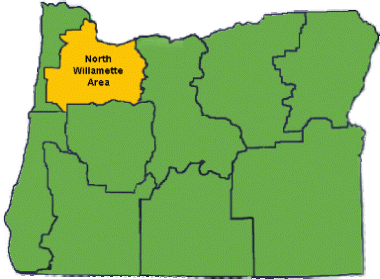
Warmwater fishing in the north Willamette area
The north Willamette area includes the Columbia River from Bonneville downstream to St. Helens and the lower Willamette Basin north of Salem. The Columbia and Willamette both offer outstanding warmwater fishing for bass and a variety of panfish including crappie. Good fishing is also available in the area's lakes and reservoirs such as Henry Hagg Lake which has produced state record smallmouth bass and brown bullhead catfish.

Although this is the most populated region of Oregon with the state's largest metropolitan area, families and young anglers will find plenty of opportunities close to home in the many smaller ponds inside and near Portland and the other urban areas where a variety of fish are available including: Largemouth Bass | Smallmouth Bass | Bullheads | Black Crappie | White Crappie | Bluegill | Pumpkinseed | Yellow Perch | Green Sunfish | Warmouth | Channel Catfish | Walleye
Featured waterbody - Henry Hagg Lake
Located less than 30 miles west of Portland near the City of Forest Grove, Henry Hagg or “Hagg” Lake offers excellent warmwater fishing near Oregon's largest urban area and the Willamette Valley. A Bureau of Reclamation dam on Scoggins Creek creates the 1,100-acre reservoir used to store water for irrigation and municipal use, and provide flood control on the Tualatin River.
Recreational facilities at Henry Hagg Lake are managed by Washington County, which charges a day use fee to enter the area -- season passes are available. Amenities include extensive facilities for the disabled angler. No camping is allowed, but there are several shelters and picnic areas, and numerous spots to stop along the road and trails that circle the lake. There are boat ramps on the east side of the lake at Recreation Area A and on the west side at Recreation Area C, which includes a concessionaire offering rentals. The majority of recreational boating occurs on the south half of the lake while the north half has been designated a “no wake zone,” making it more pleasant to fish.
Although Henry Hagg Lake is a great destination for beginners, it also is popular with more experienced anglers -- perhaps because the state record smallmouth bass and brown bullhead catfish have been caught here. Anglers also will find largemouth bass, crappie, bluegill and yellow perch. During the cooler months, native cutthroat trout are present and the lake is heavily stocked with rainbow trout.
Fishing for bass and crappie is best in mid- to late-spring when the fish move into shallow areas to spawn. For smallmouth, fish in the lake arms or smaller coves using light or medium weight spinning tackle and lures that imitate prey such as small fish and crayfish. As temperatures warm, the smallmouth bass move to deeper water so fish along areas of riprap in the south half of the lake near and along Scoggins Dam. Though not as plentiful as the smallmouth, largemouth bass can be caught in the shallow areas during this time of year. For smallmouth or largemouth, use spinners or other surface lures in the morning and evening, and during mid-day switch to jigs, plastic baits or other lures that fish deeper.
For crappie, use light spinning tackle and fish with a bobber and jig. The jig can be set at different depths until you locate the fish. Start with a lighter weight jig then try heavier weights if necessary. Be sure to have a variety of colors available. Bait can be added to the jig hook to increase the attraction -- to fish, that is. Bank anglers will find good access near the boat ramps and along the biking and hiking trails that surround the lake. Look for areas where grass, aquatic weeds, root wads and other submerged structures offer fish cover.
Fishing for crappies, as well as bluegill and yellow perch, remains good in the coves and shallows throughout the summer. This is a great time to take kids fishing as the weather is warm and panfish can still be caught using a bobber and bait fished close to the surface. A small hook baited with a worm or other panfish bait and set 12-18 inches below the bobber works well and will keep the hook above any snags. The long fishing pier located near Boat Ramp C is perfect for younger children.
Summer is also a good time to fish for catfish. Anglers will find some of the nicest brown bullhead of any water body in the Willamette Valley. During the summer, brown bullhead can be caught using bait fished on the bottom in deeper areas of the lake coves and arms. Most standard gear works well for catfish, such as a 5- to 7-foot casting or spinning rod and 4- to 8-pound test line rigged with a slip-sinker and bait. Tie a 12- to 18-inch leader below the swivel and attach a hook baited with worms or other panfish or catfish bait. Baits with a strong odor work best for catfish. The sliding sinker allows the catfish to take the bait before feeling the weight of the sinker.
When the weather and water temperatures cool in the fall, smallmouth fishing improves again as fish move back into the shallow areas to feed. You can switch back to using small fish and crayfish imitations, but plastic worms will also work well.
More warmwater fishing in the north Willamette area
Find your place to fish
Header image by Jessica Sall



